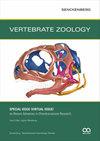印度半岛西高止山脉的银盲虫的骨学(Beddome,1870)(两栖纲:金目:大异虫科)
IF 2.4
2区 生物学
Q1 ZOOLOGY
引用次数: 0
摘要
摘要本文首次利用高分辨率x射线显微计算机断层扫描技术对最近收集到的一些材料进行了骨学研究。骨化的骨骼包括一个隐骨颅骨、下颚和脊柱。颅脑由蝶窦和颅底组成,由鼻前、额、顶骨、鳞片、翼方、上颌腭、腭和镫骨等8个颅元覆盖。眼睛被上颌腭覆盖,没有(开放的)眼窝。蝶窦不暴露,缺少鼻底或腹缘。嗅觉室缺少嗅觉隆起。在左右额叶和顶叶的结构和/或大小以及一些孔的数量和大小上观察到轻微的不对称。除了翼方骨和镫骨外,所有的骨头都被神经和/或血管的孔穿穿。下颌骨为典型的犬牙型,有牙的假牙型和无牙的假牙角型。椎骨数目在123-130之间(平均126)。脊椎骨的大小和比例各不相同。与其他无尾动物,特别是其他大目动物进行比较。Gegeneophis颅骨学的一些方面,如闭合的眼眶、末端下口和剑术是可能适应于专门的化石性的,但功能、行为和野外生态数据尚未可用来测试这一点。本文章由计算机程序翻译,如有差异,请以英文原文为准。
Osteology of the caecilian Gegeneophis carnosus (Beddome, 1870) (Amphibia: Gymnophiona: Grandisoniidae) from the Western Ghats of peninsular India
Abstract
The osteology of the poorly known grandisoniid caecilian Gegeneophis carnosus is described for the first time by applying high-resolution X-ray micro-computed tomography to some recently collected material. The ossified skeleton comprises a stegokrotaphic skull, lower jaw, and vertebral column. The braincase, composed of the sphenethmoid and os basale, is covered by eight other cranial elements viz. nasopremaxilla, frontal, parietal, squamosal, pterygoquadrate, maxillopalatine, vomer, and stapes. The eye is covered by the maxillopalatine, and an (open) orbit is absent. The sphenethmoid is not exposed and lacks a solum nasi or a ventral flange. The olfactory chamber lacks an olfactory eminence. Slight asymmetries were observed in the structure and/or size of the left and right frontals and parietals and in the number and size of some foramina. Except for pterygoquadrate and stapes, all bones are pierced by foramina for nerves and/or blood vessels. The lower jaw shows a typical caecilian pattern with dentigerous pseudodentary and edentulous pseudoangular. Numbers of vertebrae range from 123–130 (mean 126). The vertebrae are somewhat heterogenous, varying in size and proportions along the column. Comparisons are made with other caecilians, especially other grandisoniids. Aspects of the cranial osteology of Gegeneophis, such as the closed orbit, subterminal mouth, and stegokrotaphy are possible adaptations to dedicated fossoriality, but functional, behavioural, and field ecological data are not yet available to test this.
求助全文
通过发布文献求助,成功后即可免费获取论文全文。
去求助
来源期刊

Vertebrate Zoology
ZOOLOGY-
CiteScore
4.00
自引率
19.00%
发文量
42
审稿时长
>12 weeks
期刊介绍:
Research fields covered by VERTEBRATE ZOOLOGY are taxonomy, morphology, anatomy, phylogeny (molecular and morphology-based), historical biogeography, and palaeontology of vertebrates.
 求助内容:
求助内容: 应助结果提醒方式:
应助结果提醒方式:


